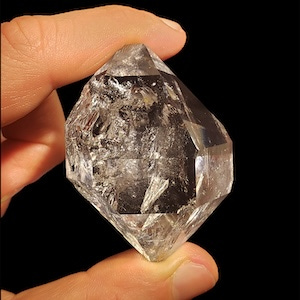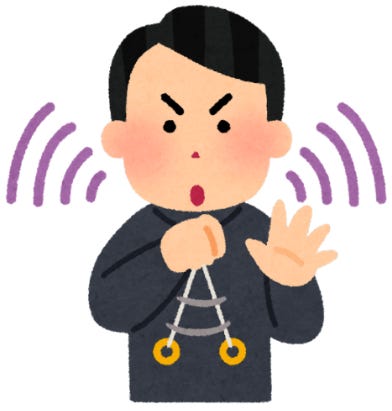Thinking About Time
Movement, at Low Energy
Hello Friends,
When I was a kid, one of my favorite things in the world was rock candy.
If you don't know, it's a semi-transparent confection made from sugar, solidified on a stick. You can create your own by dissolving sugar in boiling water. We did this at school to understand a type of matter called crystals.
If you suspend a string with a knot at the bottom in the water, the dissolved sugar molecules will collect on the string, forming an organized structure. The more the water solution cools, the more sugar molecules collect and assemble themselves into a three-dimensional repeating pattern, like stacked egg cartons.
Some materials, like quartz and diamonds, do this. Their 'natural state' is ordered in a structure that gives us a crystal.
Years ago, my wife took me to a place in Herkimer, NY, where they have a certain type of crystal called a Herkimer diamond.
They are not real diamonds, just a type of clear crystal. And they make a great roadside attraction. We cracked rocks looking for these gems for a couple of hours and unearthed some pretty cool crystals.
Physically speaking, a crystal exists when its cells are organized in a repeating pattern at its lowest energy. In other words, as the jar of sugar water cools (losing heat and energy), it forms the crystals.
No matter how much heat (energy) is lost to the surrounding room, the rock candy won’t turn into anything else. Its final resting state is an organized structure of a crystal.
A while ago I came across something called a time crystal. It was conceived by Frank Wilczek, a Nobel prized winning physicist who thinks of such things and describes them with math.
A time crystal is something that occurs when:
the continuous translational symmetry in space is broken and replaced by the lower discrete symmetry of the periodic crystal.
https://en.wikipedia.org/wiki/Time_crystal
Essentially, it's a time analogy of a regular crystal. Rather than organizing itself as repeating in space at its lowest energy level, it repeats in time.
Waaa?
Consider a pendulum. Initially, energy is put into the system to pull it to one side until it is released. Then, the forces of gravity and its own momentum keep it oscillating until it eventually stops, as its energy (momentum) leaves the system and it enters its lowest state.
Now, imagine that it doesn't stop.
Imagine that it keeps moving back and forth. No matter how much time goes by, it keeps repeating the pattern of back and forth forever—no energy enters the system. No energy leaves the system.
That is a time crystal: repeated motion at its lowest energy state.
This type of system breaks all kinds of physical laws, which is why we don't have perpetual motion machines.
Or, like what my friend Mark astutely asked: What about entropy?
It's a thought experiment.
Actual time crystals have not been created or observed. While lots of people claim to have a way to do it, no one has verifiably demonstrated one.
As a science fiction writer, I find it an incredibly useful term. I mean, how many sci-fi stories can you create that have a time crystal at the center of them?
It doesn't even have to function like the one I describe above—your time crystal could do anything. It's handy—quick, the time crystal is about to blow!
Two time crystals walk into a bar…
Besides, thought experiments are not only fun for the whole family, but exceedingly important. Much of our understanding of the universe came from someone, like Einstein, sitting around wondering… What if?
And to get really woo-woo, thoughts can become reality. But that’s a different newsletter.
Imagine if we replaced all the time and energy people spent these days thinking about scarcity and fear and hatred and instead thought about positive stuff, like time crystals and vaccines that cure cancer and how to keep communities safe and healthy.
And, sugar on a stick.
Or, hunting for Herkimer diamonds with someone you love.
Happy reading, happy writing, happy thought experimenting,
David




